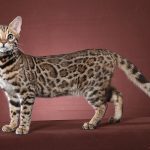Cats have a way of getting under our skin and into our hearts, with their mysterious and independent personalities and adorable features. They’ve been captivating humans for thousands of years, but where did these feline friends come from? It’s a question that has puzzled scientists and historians alike for years. So, let’s take a journey back in time to explore the history of one of the world’s most favorite animals – the domestic cat.
While cats have become ubiquitous pets across the globe, it’s widely believed that their journey began in ancient Egypt. The Egyptians revered cats and considered them sacred animals that protected their homes. However, the true origin of cats remains somewhat enigmatic. Many researchers suggest that domestic cats descended from African wildcats – small, shy, and solitary felines that still roam throughout North Africa’s deserts.
In this blog post, we’ll delve into the evolution and history of cats – exploring their genetic roots, cultural significance, and widespread adoption as beloved household pets. So sit back, relax, and get ready to discover the fascinating origins of one of our most beloved animal companions.
Origin of Domestic Cats
The origin of domestic cats has been a topic of fascination and debate among scientists and researchers for decades. While the exact time and place of their domestication remains contested, recent genetic studies have suggested that cats likely originated in the Near East region. Specifically, in what is now modern-day Turkey or Iraq.
Attracted by the abundance of rodents around human settlements, cats began to establish a mutually beneficial relationship with humans. Over time, humans began to tolerate their presence and even provide them with food. This led to the domestication of cats, which has been traced back to as early as 7,500 BC in a burial site in Cyprus where a human and a cat were buried together.
Cats quickly became valued for their ability to control rodent populations, which made them especially useful on ships. They were thus highly regarded in maritime exploration and trade, spreading throughout the world through various means.
Today, there are over 600 million domestic cats worldwide, making them one of the most popular pets. Despite their widespread popularity, however, much is still unknown about their origins and early history. Ongoing research may provide more insights into this fascinating topic in the future.
What is clear is that domestic cats have retained many of the traits that helped them survive in the wild, including their agility, hunting instincts, and independent nature. These qualities make them fascinating companions to their human caretakers.
Theory of Ancient Egyptian Domestication
It is widely known that cats held a significant place in this ancient civilization, even being worshipped as deities. But where did their domestication truly begin?
One theory suggests that cats were first domesticated in Egypt around 4,000 years ago. With rodents and pests posing a serious threat to crops and supplies, cats were highly valued for their pest control abilities. Egyptians began selectively breeding cats for specific traits such as hunting skills and temperament, leading to the development of various cat breeds.
Another theory places the origins of domesticated cats in the Near East around 10,000 years ago. Genetic evidence supports this theory, showing that all domesticated cats descended from Felis silvestris lybica, a wildcat species native to the Near East.
Regardless of where domestication began, it is undeniable that cats played a crucial role in Ancient Egyptian culture. Cats were kept as pets by both commoners and royalty alike, with many mummified cats found in tombs throughout Egypt. The cat goddess Bastet was revered for her protection of homes and families from harm.
As we continue to cherish our feline companions today, it is fascinating to look back on their history and evolution. While we may never know for certain where cats were first domesticated, we can appreciate their enduring presence in our lives and their remarkable ability to adapt and thrive alongside humans.
Genetic Studies of Near Eastern Origins
The answer lies in the world of genetic studies. Recent research has revealed that domesticated cats are descendants of African wildcats (Felis silvestris lybica) that lived in the Near East region around 10,000 years ago. Here are some intriguing findings that genetic studies have uncovered about the origins of domesticated cats:
The gradual domestication process: While evidence of domesticated cats dates back to 7500 BCE in Cyprus, genetic studies have shown that the process of domestication was a slow and gradual one that took place over thousands of years. It wasn’t until the ancient Egyptians began keeping cats as pets and protectors of their grain stores that the domestication of cats became widespread.
The spread of domesticated cats: Domesticated cats were highly valued by farmers and merchants as they could control rodent populations. Genetic studies have revealed that humans likely transported cats along trade routes from the Near East to other parts of the world, including Europe and Africa.
The role of genetics in cat behavior: Genetic studies have also shown that certain genes may play a role in determining a cat’s behavior and personality traits. For instance, one study found that cats with a particular gene variant were more likely to exhibit social behaviors towards humans.
The impact of genetic studies on our understanding of cat history is fascinating. It has provided insights into the gradual process of domestication, the spread of domesticated cats around the world, and even their behavior. These findings have highlighted the importance of our feline companions throughout human history.
Spread of Cats Through Trade Routes and Migration
Well, the fascinating history of cats dates back thousands of years and is intertwined with the development of trade routes and migration.
While there is still debate among experts about the exact origin of domestic cats, recent genetic research suggests that they may have been independently domesticated in several regions of the world. However, what is indisputable is that cats spread throughout the world through trade routes and migration.
As early civilizations developed trade and commerce, cats were often brought along on ships to control the rodent population. This allowed cats to spread to new regions and establish themselves as valued companions. The ancient Egyptians were particularly fond of cats and believed that they had protective powers, which led to their widespread presence throughout Egypt and their eventual spread through trade routes.
Cats’ popularity continued to grow during the Age of Exploration in the 15th and 16th centuries. European explorers brought cats along with them on long voyages across the globe to keep rodents at bay, leading to their introduction in regions like North America, Australia, and New Zealand where they previously did not exist.
Cats’ ability to adapt to their surroundings has made them an integral part of many different cultures and regions. They have proven time and time again that they can thrive anywhere, whether lounging in sunny windowsills or catching mice on ships.
Popularity Among Rural Dwellers
For thousands of years, cats have been an essential part of human society. And in rural areas, their popularity is undeniable. As a researcher on this topic, I’ve discovered why cats are so beloved among those who live beyond the city limits.
One reason for their popularity is their innate ability to hunt. Cats make excellent companions for farmers and other rural dwellers due to their ability to control rodent populations. Mice and rats can pose a significant threat to crops and stored food, but with cats around, these pests don’t stand a chance. This makes them invaluable for keeping farms and homes free from vermin.
Another reason for the popularity of cats in rural areas is that they are low-maintenance animals. They don’t require much food or attention, making them ideal for those living in remote locations where resources may be limited. This means cats can thrive even in areas where other types of pets might struggle.
However, life isn’t always easy for free-roaming cats in rural areas. They face various dangers, such as predators like coyotes and foxes or cars on busy roads. Despite these risks, many rural dwellers see cats as essential members of their communities and take great pride in caring for them.
In some rural areas, programs are in place to control feral cat populations and ensure that domestic cats receive proper veterinary care. This demonstrates just how important cats are to those who live beyond city limits.
Cats in Modern Homes and Apartments
Cats are not only popular pets, but they have become one of the most beloved household companions in modern times. They are a perfect match for people who live in apartments or small homes due to their independent nature and charming personalities.
In recent years, keeping cats as indoor-only pets has become increasingly popular due to concerns about the dangers of outdoor living for cats. Modern homes and apartments provide the perfect environment for indoor cats, with plenty of space to explore and play.
However, despite their low-maintenance nature, cats do require some special considerations when living in modern homes and apartments. One of the crucial things to keep in mind is providing them with plenty of vertical space to climb and play. Investing in a tall scratching post or cat tree can make all the difference as it not only provides a place to play but also helps them feel more secure in their new home.
In addition, ensuring that your home is safe for your cat is essential. This includes keeping toxic plants out of reach, securing windows and balconies to prevent falls, and keeping small items that could be swallowed out of reach.
Despite these necessary precautions, cats are well-suited to life in modern homes and apartments. They’re low-maintenance pets that can provide endless entertainment and companionship. With their independent nature, they’re perfect for people who may not have the time or space for a more demanding pet.
Retention of Wild Traits
These traits have been developed over millions of years of evolution and are deeply ingrained in their DNA.
One of the most notable wild traits that domestic cats possess is their hunting instinct. Even if they’ve never been outside, their natural desire to stalk and pounce on prey is still present. Providing them with interactive toys and playtime can help satisfy this instinct and prevent boredom.
In addition to their hunting instinct, domestic cats have a strong sense of territoriality. They require their own personal space and may become agitated if they feel that their territory is being invaded. Providing your cat with a designated area such as a cat tree or cozy bed can help them feel safe and secure in their environment.
Despite forming bonds with their human caregivers or other cats in the household, domestic cats still require time alone to recharge. Respecting their need for solitude can prevent stress and anxiety.
Notably, domestic cats are similar to their wild counterparts in that they are solitary animals except during mating seasons. While they may form bonds with other cats, they still require their own personal space and time alone.
Finally, it’s essential to understand that cats are unique individuals with distinct personalities and preferences. Some may be more social than others, while some may prefer a more independent lifestyle. By taking the time to understand your cat’s individual needs and behaviors, you can provide them with the best possible care and enrich their lives as much as possible.
Conclusion
In conclusion, the origin and evolution of cats is a captivating tale that has intrigued cat lovers, researchers, and scientists alike for centuries. Despite their mysterious beginnings, recent genetic studies have illuminated the gradual domestication process of cats and their widespread adoption as beloved household pets.
From their humble origins in the Near East region to their revered status in ancient Egyptian culture, cats have played a pivotal role in human society throughout history. Their innate ability to adapt to different environments and control rodent populations made them valuable companions for farmers and merchants alike, leading to their proliferation through trade routes and migration.
Today, cats remain enchanting creatures that continue to charm us with their enigmatic personalities and adorable features. Whether they’re lounging on sun-drenched windowsills or pouncing on toys, they retain many of the traits that helped them thrive in the wild.
To ensure our feline friends receive optimal care, it’s crucial to appreciate their unique needs and preferences. By providing them with ample vertical space to climb and play, respecting their desire for solitude, and understanding their hunting instinct and territoriality, we can guarantee they receive the best possible care.
Ultimately, whether you reside in a rural area or a modern apartment complex, cats make exceptional companions that bring joy and affection into our lives.







